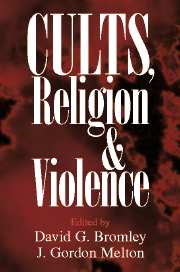Book contents
- Frontmatter
- Contents
- Acknowledgments
- Contributors
- Prologue
- 1 Violence and Religion in Perspective
- 2 Dramatic Denouements
- 3 Challenging Misconceptions about the New Religions–Violence Connection
- 4 Sources of Volatility in Religious Movements
- 5 Crises of Charismatic Legitimacy and Violent Behavior in New Religious Movements
- 6 Public Agency Involvement in Government–Religious Movement Confrontations
- 7 Watching for Violence: A Comparative Analysis of the Roles of Five Types of Cult-Watching Groups
- 8 Mass Suicide and the Branch Davidians
- 9 Occult Masters and the Temple of Doom: The Fiery End of the Solar Temple
- 10 Dramatic Confrontations: Aum Shinrikyô against the World
- 11 Making Sense of the Heaven's Gate Suicides
- 12 Lessons from the Past, Perspective for the Future
- Index
- References
3 - Challenging Misconceptions about the New Religions–Violence Connection
Published online by Cambridge University Press: 09 July 2009
- Frontmatter
- Contents
- Acknowledgments
- Contributors
- Prologue
- 1 Violence and Religion in Perspective
- 2 Dramatic Denouements
- 3 Challenging Misconceptions about the New Religions–Violence Connection
- 4 Sources of Volatility in Religious Movements
- 5 Crises of Charismatic Legitimacy and Violent Behavior in New Religious Movements
- 6 Public Agency Involvement in Government–Religious Movement Confrontations
- 7 Watching for Violence: A Comparative Analysis of the Roles of Five Types of Cult-Watching Groups
- 8 Mass Suicide and the Branch Davidians
- 9 Occult Masters and the Temple of Doom: The Fiery End of the Solar Temple
- 10 Dramatic Confrontations: Aum Shinrikyô against the World
- 11 Making Sense of the Heaven's Gate Suicides
- 12 Lessons from the Past, Perspective for the Future
- Index
- References
Summary
The expansion of religious diversity in the West over the last half century, and particularly the rise of what have been termed “new religious movements,” has produced a a major scholarly reassessment of the place of religion in the social order as well as a strong public reaction to the beliefs, practices, and leadership of a number of the new movements. The conservative wing of the Christian community has repudiated what it regards as deviation from the true Christian tradition by publishing hundreds of theological exposés of cultic heresy. Parents of converts to new religious movements have banded together to form an anticult movement that has rejected the religious legitimacy of the groups and affiliations with them. In their wake, a critical cult-awareness movement led by members of the legal and psychological professions has arisen to call attention to groups believed to be physically or psychologically harmful to their members and to the public at large. An array of governmental agencies have come into conflict with religious movements over issues ranging from tax-exempt status to immigration regulations to church–state boundary issues. Media portrayals of these various conflicts have created the specter of a public menace by employing the designation “cult” as a common link that homogenizes religious movements. Scholars have mounted a major research program to interpret the religious meaning and social significance of the movements and generally have resisted the invariant and obfuscating cult appellation.
- Type
- Chapter
- Information
- Cults, Religion, and Violence , pp. 42 - 56Publisher: Cambridge University PressPrint publication year: 2002
References
- 3
- Cited by



